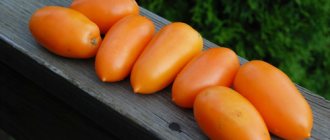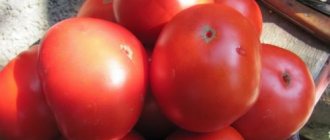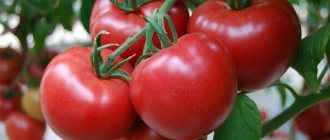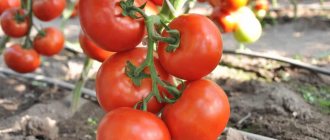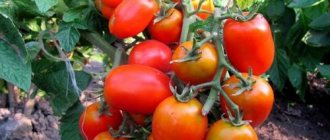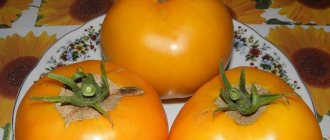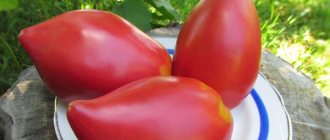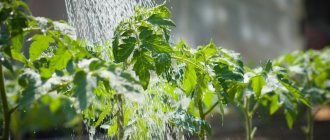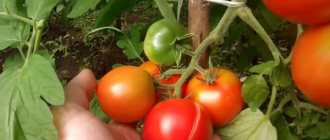Description of the variety
The Tsar Bell tomato variety has semi-determinate compact bushes of standard type. The height of the main stem on average reaches 90-100 cm, but when the crop is grown in greenhouse conditions, the tomato grows up to 150 cm.
Due to their high growth, it is recommended to tie the plants to prevent the leading stem from breaking under the weight of large vegetables. The bush has large dark green leaves.
Distinctive features
The Tsar Bell tomato is grown both in open ground and in greenhouses. The sizes of vegetables grown in greenhouse conditions are usually larger than those cultivated in an area without shelter. In general, the variety tolerates temperature changes and unfavorable environmental conditions well.
Fruit characteristics and yield
One of the main features of the variety is the large-fruited tomatoes. The average weight of one tomato is 650 g.
If agrotechnical rules are observed (with timely application of fertilizers and abundant watering when growing tomatoes in a greenhouse), the fruits gain weight up to 800 g.
The largest tomatoes are formed on the lower shoots. Tomatoes that ripen first tend to be larger than those that ripen later.
The shape of the fruit is round, slightly elongated. The surface is smooth, but in the area of the stalk there is a faint ribbing.
Ripe vegetables are dark red or dark pink. The shell of tomatoes is not thick, but dense, so the fruits do not crack. The pulp is juicy and fleshy, moderate wateriness. The acidity and sugar content of vegetables combine and form a pleasant sweetish taste without pronounced sourness.
The first tomatoes ripen 105-110 days after emergence. Productivity largely depends on the region where the variety is grown. In addition, the amount of yield is affected by the frequency of watering and fertilization.
On average, 4 kg of crop is harvested from one bush, but with good care and cultivation in greenhouse conditions, this figure increases to 6 kg per plant.
Features of the variety
Characteristics and description of the Tsar Bell tomato variety:
- average ripening time;
- determinate bush;
- bush height from 0.8 to 1 m;
- large dark green leaves;
- the first ovary develops above the 9th leaf, further ones - after 1-2 leaves.
The fruits of the Tsar Bell variety have the following features:
- heart-shaped;
- bright red color at maturity;
- average weight 200-350 g;
- maximum weight 600 g;
- fleshy pulp;
- good sweet taste.
Tsar Bell tomatoes are of the salad type. They are used for preparing appetizers, salads, sauces, first and second courses.
Important! The average yield of the variety is 8.6 kg per 1 sq. m landings. With fertilizing and constant watering, the yield increases to 18 kg.
Tomatoes are picked green and stored at room temperature, where they ripen quickly. In home preparations, the variety is used to obtain tomato juice and assorted vegetables.
How to grow seedlings
The Tsar Bell tomato is grown from seedlings. This takes about 50-60 days. First, the seeds are disinfected and germinated at home. Grown plants are transferred under a film cover or directly into open ground.
Seed preparation
If the seeds are colored in an unusual color, then they do not need additional processing of the grain - they have already been disinfected and kept in a nutrient solution by the manufacturer. If the seeds are purchased from hand or collected from your own harvest, then before sowing the grains are disinfected as follows:
- to destroy pest larvae and eggs, seed material is placed in hot water for 10-15 minutes;
- from possible fungi, mold and rot, the seeds are disinfected in a weak (1%) solution of potassium permanganate (the grains are kept in it for 20-30 minutes).
For accelerated germination and uniform germination, tomato seeds are soaked in a growth stimulator for 15-20 hours. For this purpose the following drugs are used:
- "Energen";
- "Zircon";
- "Baikal-EM1".
The products are sold in specialized stores. They are used strictly according to the instructions indicated on the packaging.
Container and soil
Seedlings are grown in different containers:
- disposable cups;
- wooden or plastic boxes;
- special purchased containers with cells and a lid;
- peat cups or tablets;
- cut milk bottles or cartons.
Seedlings require light nutritious soil, which can be purchased at the store or prepared independently by mixing turf soil, river sand and humus (1:1:1).
Important! Before use, the soil mixture is etched with a weak solution of potassium permanganate to prevent contamination of the seeds by pathogenic organisms.
Sowing
Sowing grains for seedlings is carried out in March or April - it all depends on the climatic characteristics of a particular region.
The prepared container is filled with soil, then grooves no deeper than 1.5-2 cm are made in the soil and seeds are sown in them. Cover the top with a small layer of peat, spray it with a spray bottle, cover it with film or transparent glass and place it in a warm place with an air temperature of about +25 °C.
Growing and care
When shoots appear, the film is removed and the container is sent to a well-lit place - for example, on a windowsill. The room temperature is lowered by several degrees. The optimal air temperature during the day is +20...+22 °C, and at night +10...+15 °C.
As the soil dries, moisten it with a spray bottle. For this purpose, settled and warm water is used. Seedlings should be illuminated for 10-12 hours a day. During short daylight hours, phytolamps are evenly installed above the bushes as additional lighting.
When the seedlings have their third true leaf, the plants are planted in separate containers. But if the tomatoes were originally planted in different pots, replanting is not carried out.
Features of cultivation
Seeds are sown for seedlings in early March. The soil should be light, consisting of equal parts of turf soil and old humus. For more airiness, you can add a little washed river sand to the mixture. Read more about the types of soil for tomatoes and the soil most suitable for greenhouse plantings.
The seeds should be soaked in a growth stimulator. It is not necessary to disinfect them; the seed goes through all the necessary manipulations before sale. Sowing is carried out with a depth of 1.5-2 cm. The plantings are sprinkled with a layer of peat on top and sprayed with warm water from a spray bottle.
Germination requires warmth; the temperature should not fall below 25 degrees . After the sprouts appear, the temperature in the room is slightly reduced, and the containers are exposed to bright light. Picking seedlings is carried out at the stage of formation of the first true leaves. Young plants need to be fed twice with an aqueous solution of complete complex fertilizer.
Planting in greenhouses is carried out in the first half of May; plants are moved into the ground towards the end of the month. In the first days it is better to cover them with film. For 1 sq. m you can place 3 bushes; thickening of plantings is undesirable.
Watering is carried out every 6 days, only warm, settled water is used. Mulching will help control weeds. During the season, plants are fed 3-4 times with complex fertilizer based on phosphorus and potassium. The bush is formed into 1 stem, the side shoots are removed.
How to grow tomatoes
Seedlings are planted in a permanent place of growth no earlier than the end of May - beginning of June. Hypothermia of the root system will reduce the yield, so the plants are transplanted into well-warmed soil of 8-10 cm.
The crop is demanding on lighting, so tomatoes are placed in a well-lit area away from buildings and trees. The bed is prepared in the fall: it is cleared of weeds and remains of cultivated plants, then the soil is sprinkled with humus and dug up.
Landing
When the plants grow to 30 cm, they are transplanted into open ground or a greenhouse. By this time, the bushes will have 6-7 leaves and will bloom. Before planting, 3 lower leaves are removed from the plants to provide the tomatoes with good lighting.
Good predecessors for tomatoes are cabbage, cucumbers, melons, root vegetables, and green manure. Tomatoes are not grown for two years in a row in the same place or after potatoes, eggplants and peppers.
Plants are planted in previously prepared holes. The bushes are placed at a distance of 40 cm from each other, and 60 cm are left between the rows. To ensure that the plants receive more sunlight, the crops are placed in a checkerboard pattern.
The tomatoes are transferred to a permanent place along with a lump of earth. The roots are sprinkled with soil, which is lightly compacted. Then the plants are watered abundantly.
Care
With good care, the crop will not get sick and will produce a good harvest. The plant requires watering, fertilizing and bush formation. After planting, tomatoes are watered for 7-10 days. During this period, tomatoes adapt to a new place.
Moisturize the culture as follows:
- Before the ovaries form, water the tomatoes once a week (4 liters per bush);
- During fruit ripening, tomatoes are moistened twice a week (3 liters of water per plant).
If the Tsar Bell grows in a greenhouse, then the structure must be ventilated after watering to prevent high humidity and the occurrence of fungal diseases.
The crop is watered with settled or rainwater at room temperature. Exposure to cold will slow down plant development.
Tomatoes are fertilized several times a season. At the beginning of the growing season, plants are given fertilizers containing nitrogen. In the future, to strengthen the root system and improve the taste of the fruit, the bushes are fertilized with potassium and phosphorus.
Tomatoes are fed according to this scheme:
- 14 days after planting the plants in a permanent place, the crop is fertilized with liquid mullein diluted with water in a ratio of 1:15;
- after another two weeks, the tomatoes are fed with a solution of superphosphate and potassium salt (25 g of each product per bucket of water);
- The next fertilization is carried out during fruit ripening with a solution of potassium humate (1 tbsp per 10 liters of water).
Wood ash is a good substitute for mineral fertilizers. It is embedded in the soil or added to water for irrigation.
The variety is formed into 1-2 stems . The stepsons that grow from the leaf sinus are removed. The first pinching is carried out after transplanting the plants into open ground or a greenhouse. Once a week, the lateral shoots of the plants are broken off, leaving stumps up to 3 cm. During the period of fruit ripening, the lower leaves of the plants are removed. This way the bushes will be better ventilated, and as they grow in the greenhouse, the humidity level will decrease.
In order for oxygen to penetrate to the root system, the soil around the plants is loosened to a depth of 5 cm, in row spacing - 10 cm. The activity is carried out 12-24 hours after watering. Along with loosening, weeds are removed so that they do not take away nutrients from the tomatoes. After aeration, the soil is mulched with compost. This will provide the plants with additional nutrition and help retain moisture in the soil longer in hot weather.
Features of cultivation and possible difficulties
The agricultural technology of the Tsar Bell variety is no different from growing other tomatoes. To obtain a bountiful harvest, plants are provided with timely watering and regular fertilizers.
Diseases and pests
The variety has strong immunity to most nightshade diseases. Tomato Tsar Bell has good resistance to fungi and diseases such as:
- verticillium;
- fusarium;
- late blight
Tomato resistance to diseases is high, but to be sure, experienced vegetable growers carry out preventive measures. To reduce the risk of plant disease, the soil is disinfected with a hot solution of potassium permanganate.
After transplanting the tomatoes to a permanent place, the bed is sprayed with any fungicide, for example:
- "Quadris";
- "Acrobat";
- "Ridomil";
- "Agate 25K";
- "Maksim".
The tomato has average resistance to pests. Most often, the crop is affected by insects such as whiteflies, wireworms, and aphids.
To repel insects, peat and humus are added to the soil. To prevent pests from breeding, weeds are regularly removed. Treat the soil with a light soap solution - this will help get rid of aphids. Wood ash or tobacco dust is used against slugs. Folk remedies are replaced with insecticides, for example, "Aktellik", "Confidor", "Karate" or "Fitoverm".
Obtaining seedlings
I grow Tsar Bell tomatoes by seedlings. First, the seeds are germinated at home. The resulting seedlings are transferred under cover or directly to the beds.
Planting seeds
To plant Tsar Bell tomatoes, prepare fertile soil fertilized with compost. For the culture, you can use purchased soil intended for seedlings. An alternative option is to plant tomatoes in peat pots.
Advice! To disinfect, garden soil is steamed in a microwave and oven.
Seeds of the Tsar Bell variety are placed in a moistened cloth for a couple of days. You can speed up the appearance of sprouts using any growth stimulator.
If the Tsar Bell tomato seeds are brightly colored, then they do not need additional processing. Such planting material is covered with a nutrient shell containing substances necessary for the development of sprouts.
Containers are filled with prepared soil. For tomatoes, containers up to 15 cm high are enough. The seeds are placed on the surface of the soil with an interval of 2 cm. The seeds are covered with earth or peat 1.5 cm thick.
Important! The containers must be covered with film or glass to create a greenhouse effect, and then left in a dark place.
At temperatures above 25 degrees, seed germination takes 2-3 days. When shoots appear, the containers are moved to a windowsill or other illuminated place.
Conditions for seedlings
Tsar Bell tomato seedlings actively develop when certain conditions are provided:
- temperature during the day: 20-25 degrees, at night – 10-15 degrees;
- constant soil moisture;
- access to fresh air in the absence of drafts;
- lighting for half the day.
The soil is moistened as it dries. Water the tomatoes using a spray bottle. You need to use warm, settled water. Until the plants develop 4-5 leaves, they are watered weekly. In the future, moisture is added every 3 days.
When the Tsar Bell tomato seedlings have 2-3 leaves, they are planted in separate containers. If the seeds were planted in cups, then picking is not required.
Advice! If the seedlings look depressed, they are fed with a solution of the drug Kornerost (1 tsp per 1 liter of water).
A couple of weeks before planting, tomatoes are prepared for changing growing conditions. Gradually reduce the intensity of watering, and transfer the seedlings to fresh air. First, the plants are kept on the balcony or loggia for 2 hours, gradually increasing this period.
The nuances of growing in open ground and in a greenhouse
During the entire growing season, about three hillings are carried out, especially if the root system is washed away during watering, as well as as the lower leaves grow and are torn off. When the first flowers or fruits appear, the plants are tied to a support so that the main stem does not break due to the weight of large fruits.
Transplanting seedlings
Tomatoes are planted in open ground no earlier than the end of May - early June.
Hypothermia of the root system reduces fruiting, so seedlings are planted in soil that has warmed up to 10-15 cm. The variety requires good lighting, so it is placed away from trees and shrubs.
The bed is prepared in the fall, it is cleared of weeds, sprinkled with humus and dug up.
In the spring, the bed is re-cultivated, leveled with a rake and holes are dug in a checkerboard pattern.
The distance between plantings is 40 cm, and in rows - 60 cm. When tomatoes are transferred to open ground, they grow up to 30 cm, form 7-9 leaves, and sometimes begin to bloom. The hole is filled with water, sprinkled with ash and humus.
Seedlings are planted together with peat cups so as not to injure the delicate root system. The bushes are covered with earth and watered again with settled water.
Harvesting and application
The fruits are harvested approximately 3.5 months after sowing. Tomatoes are often picked unripe, as they ripen well indoors at room temperature. Thanks to their thick skin, tomatoes can be stored for several months in proper conditions without losing their appearance or taste.
Fresh salads are prepared from the fruits of this variety. Tomatoes are also great for making juice, sauce and ketchup. Since tomatoes are large in size, they are not suitable for whole-fruit canning.
Important! The Tsar Bell variety is recommended for children's and dietary nutrition, as the fruits contain a large amount of beta-carotene.
Disease prevention and pest control techniques
Tsar Bell tomatoes have a very good immune system.
They are resistant to verticillium, late blight and fusarium. However, in order to protect plants and the future harvest, experienced gardeners recommend taking a number of preventive measures. Before planting seedlings in permanent soil, the ground is treated with boiling water from potassium permanganate. Tomatoes are mechanically sprayed with phytosporin, which has a good antifungal effect. If the first signs of late blight appear on the berries or leaf blades, then the affected fruits and leaves are immediately cut off, and the area and all bushes are treated with special copper-containing preparations. The main method of pest control is mulching the soil with humus, peat and timely removal of weeds. If the plants are attacked by aphids, the tomatoes are sprayed with a soap solution. 250 gr. Laundry soap is grated on a fine grater and dissolved in 10 liters of warm water. The mixture is thoroughly mixed and cooled. Colorado potato beetle larvae and slugs can be destroyed using a hydrogen peroxide solution, according to the instructions.
Tsar Bell tomatoes are one of the most popular varieties of tomatoes, which contain a huge amount of beta-carotene in their fruits. Due to the beneficial properties and microelements of the drug, the fruits are often used to make baby purees and dietary foods. Tomatoes are used not only for preparing salads, but also for appetizers, sauces, first courses, assorted vegetables and tomato juice.
Sergey, 47 years old, Ukraine
Three years ago, a friend advised me to plant Tsar Bell tomatoes. The variety interested me not only for its large fruits, but also for its stable yield. The process of growing and caring for me did not cause any difficulties. The seedlings grew strong and healthy. I planted seedlings in open ground. The approximate weight of the fruit was from 200 to 350 grams, but there were several tomatoes weighing 500 grams. This year I plan to add several dozen bushes to try to cover the tomato paste.
Olga, 51 years old, Krasnodar
I started growing this variety three years ago. The first time I had to buy Tsar Bell tomato seeds on the Internet, since they were not available in specialized stores. Now every year I collect seeds from the berries and plant my own grains. During the entire period of growing tomatoes, there were no pests or diseases. I use it both raw and can whole smaller fruits.
Svetlana, 63 years old, Moscow region
In 2021, I accidentally saw the Tsar Bell variety on the Internet. I read a lot of reviews, watched detailed video instructions on propagation and care, and in the summer I decided to plant tomatoes at my dacha. The bushes did not grow too large, but at the moment the fruits ripened, the seedlings had to be tied to a wooden support. To prevent the berries from being exposed to various diseases, the plants were constantly pinched. The harvest turned out to be quite large. I closed a lot of cans of tomato juice and ate tomatoes until the end of November.
Advantages and disadvantages of the variety
Vegetable growers value the Tsar Bell tomato for its following advantages:
- high level of productivity;
- crop resistance to diseases;
- high seed germination;
- plant resistance to low temperatures;
- presentation of the fruit;
- early ripening of the variety;
- excellent taste;
- fruit resistance to cracking;
- transportability of vegetables.
The variety has few disadvantages:
- the need to form a plant and a garter;
- the variety is highly demanding when it comes to fertilization, since large fruits require large amounts of nutrients;
- tomatoes are not suitable for whole-fruit canning.
Pros and cons of the variety
- pros
- large fruits of high commercial quality;
- high level of productivity;
- disease resistance;
- high percentage of seed germination;
- resistance to low temperatures.
- Minuses
- the need to form a bush and a garter even with its small dimensions;
- demands on fertilizing, since large-fruited ovaries require increased volumes of nutrients;
- The fruits are not suitable for canning in their entirety.
Farmer reviews
The Tsar Bell is unpretentious in care, except for the need for regular fertilization to increase productivity. The variety received high marks, and the high transportability of the fruits makes them suitable for growing for sale.
Vladimir, Krasnodar: “Last year I tried to grow the Tsar Bell tomato variety for the first time. There were no difficulties. The tomatoes grew large, as in the photo of the package with seeds. The vegetables taste sweet, without much sourness. To obtain an abundant harvest of large-fruited tomatoes, the crop was grown in a greenhouse. I fertilized the plants three times a season and watered them well. I was pleased with the harvest. One tomato weighed about 750 g. My wife made delicious juice from these tomatoes. The Tsar Bell is not suitable for conservation at all. In general, the family liked the variety. Next time I’ll grow it again.”
Ivan, Kursk: “Once I saw a neighbor’s large-fruited tomatoes. I also wanted to grow the same ones. He advised me to plant the Tsar Bell variety. I plant seedlings in open ground. The culture was practically not sick. I fed the tomatoes 3 times. Watered the plants regularly. What I especially liked was the early ripening of the variety. The vegetables, although large, do not crack. The tomatoes are tasty and meaty. I liked the Tsar Bell, I recommend it to everyone.”
Description and characteristics of the variety
Red bell is a high-yielding and promising cherry that gardeners should pay attention to. It is part of the mid-early line, suitable for open and protected areas (greenhouses, greenhouses, tunnels). Fruiting and harvesting begin 108-112 days after germination.
Fruiting and harvesting begin 108-112 days after germination.
What are the features of the variety:
- indeterminate growth;
- strong, vigorous bushes (height 1.5-1.6 m);
- fruiting in clusters;
- in 1 brush up to 10-15 cherry bells;
- moderate foliage.
Beautiful cherry tomatoes have a pleasant sweet taste with fruity notes. The fruits are ideal for snacks and for decorating side dishes. They can be canned and served as pickles.
Description of tomatoes:
- average weight 20 g;
- diameter 2-3 cm;
- thin skin, not cracking;
- the pulp is tender, juicy;
- few seeds;
- The color is rich, bright red.
Attractive clusters ripen quickly and the harvest is harvested in clusters throughout the summer.
Diseases and pests and their prevention
The variety is highly resistant to most diseases, however, in the absence of adequate care, it can still be susceptible to late blight. When the first signs of this disease appear, you need to remove the infected parts of the plants and spray with a 1% solution of copper sulfate, and also adjust the humidity in the soil by adding peat mixed with ash to the beds (500 g of ash per 10 kg of peat).
Also find out what diseases of tomato seedlings there are.
Other fungal diseases appear very rarely. To prevent the appearance of fungi, plants are sprayed with “Fitosporin” according to the instructions.
Among the pests that are dangerous for the variety in question:
- Colorado potato beetle - the drug "Aktara", diluted according to the instructions, will help eliminate it;
- mole cricket - destroyed using Medvetox (granules are buried in the soil along the entire perimeter of the bed).
Growing seedlings
The key to a bountiful harvest is high-quality seed material. It is purchased from trusted sellers who can present quality certificates.
Close attention is paid to the appearance of the packaging. It must be intact, it must indicate the expiration date and a description of the method of growing tomatoes.
Seed preparation
Purchased seed is disinfected by placing it in a 1% solution of potassium permanganate for 30 minutes.
If the seeds are bright in color, then no additional processing is needed; they are already disinfected and kept in a nutrient.
Tomato seeds are placed on wet gauze and left for several days.
Reviews
Vladimir
Growing tomatoes of this variety did not cause me any difficulties. The bushes grew well: the stems are strong, the plant itself is powerful. The fruits themselves were simply huge, some weighed 700 grams. Very juicy tomatoes, tasty, with a slight sourness. When growing, I did not use any special fertilizers, only organic matter and simple mineral compounds.
Valentina
Delicious tomatoes, I’m very glad I bought this variety. Very simple care, no tricks and so on. The bushes grow compact and branch moderately. They were about a meter tall. Of course, you need to tie it up, but there was no particular hassle with it. Since I took this variety for the first time, I tried to please the tomatoes and fertilized it a lot. As a result, the fruits grew simply gigantic, almost a kilogram. Honestly, I've never seen tomatoes like this. At first I couldn’t even adapt to cutting such tomatoes.
Nina
My Tsar-bell tomatoes turned out to be small in size, weighing a maximum of 500 grams. My fault is that our land is not very fertile, and we put little fertilizer in it. Probably there just wasn't enough food. And these are very promising tomatoes, I will plant them next year and see what grows.
Alexei
I have been growing Tsar Bell tomatoes for five years and am always pleased with the results. I exclusively use my own seeds for seedlings, since stores often sell low-quality products. The seeds have good germination and the seedlings grow strong. In early May I plant tomatoes in the greenhouse. At the end of July we eat the first tomatoes. I am very pleased with their taste and appearance. I recommend this variety to everyone. You will not regret!
Tomato Tsar Bell: characteristics and description, reviews, photos, variety yield
“Tsar Bell” is one of the priority tomato varieties of Russian selection. It is famous for its extraordinary large-fruited size, as well as its ease of care and early ripening of delicious, selected tomatoes.
Characteristics of the variety
Tsar Bell has an average ripening time, which is 100-110 days from the moment the seeds are sowed for seedlings. Usually, with the correct growing technique, gardeners begin to feast on sweet, aromatic fruits already in July.
This variety is characterized by a determinate type of bush, that is, the plant itself stops growing after the formation of all flower clusters. The plants grow short, compact, up to one meter high (in a greenhouse the bush can stretch up to 1.5 meters).
The large, strong stem is covered with 7-9 flower clusters with large, dark green, simple-shaped leaves. The first ovary is formed above the ninth leaf, the next ones - after 1-2 leaves. The fruits are formed 4 pieces per cluster.
Since the bush grows powerful and each cluster holds several heavy fruits, it is recommended to use supports and a garter (in some cases, each cluster is tied). For a better harvest, it is recommended to form the plant into two stems.
A distinctive feature of the variety is its giant heart-shaped fruits, which reach a weight of 800 grams (the average is 400-600 grams). Tomatoes are characterized by a bright red color (sometimes with a crimson tint) with a dense, smooth skin and a fleshy interior. Tomatoes have both a sweetish tint and sourness, but in moderation.
Fact:
with good feeding and growing in greenhouse conditions, the weight of one fruit can reach 1 kilogram.
Tsar Bell is a salad type of tomato. It goes well for slicing, as well as for preparing second courses. But these tomatoes exhibit their taste best when fresh. But for canning it is better to use other varieties.
The yield of the variety is average. Usually about 8-9 kilograms are collected from one square meter. However, with increasing doses of fertilizers, the yield can increase by 1.5-2 times.
Tomatoes ripen quickly after being picked and do not crack or get soggy. They do not lose their appearance during long-term transportation, and are also stored for a long time.
Advantages of the variety:
- large-fruited;
- fruits are stored for a long time;
- easy to care for;
- withstands temperature changes;
- tomatoes do not lose their excellent appearance during transportation;
- is immune to major diseases.
Features of cultivation
Tsar Bell tomatoes are grown through seedlings, which can be planted both in open ground and in a greenhouse. You need to sow the seeds at the end of March or early April.
Before planting, seeds are usually soaked in a disinfectant composition and sprayed with a growth stimulant. Before planting the seeds in the soil, they are placed in warm, damp fabric material for a couple of days. During this time, the seeds will swell, and after planting in the ground, sprouts will appear very quickly, within 3-4 days.
Attention!
Purchased seeds have already undergone all the necessary processing, so they can be immediately sown in seedling boxes. The treated seeds are colored red.
The sowing soil should be airy and well drained. To do this, the earth is mixed with humus and a little river sand is added, which improves the conductivity of water and air. The soil is also disinfected by soaking it in manganese infusion or calcining it in the microwave or oven.
Seeds are sown in a shallow container, deepening the seeds by 1-1.5 centimeters. Leave at least two centimeters between the seeds so that the roots can develop freely.
After sowing, carefully moisten the soil, avoiding washing out the seeds. Then the containers are covered with film and placed in the shade. Due to the resulting greenhouse effect, seedlings will be fast and simultaneous. When all the shoots hatch, the film is removed, and the boxes with seedlings are placed in a lighted place (window sill).
Care during the seedling period:
- The air temperature should be 22-25 degrees Celsius during the day and 15 degrees at night.
- Seedlings should be illuminated for at least 16 hours a day.
- The soil should always be semi-moist.
- To prevent the seedlings from rotting, it is necessary to carry out periodic ventilation, avoiding cold air currents.
- Young seedlings need to be watered by sprinkling. The water should only be warm and settled.
As soon as two leaves appear on the bushes, the seedlings are picked, that is, planted in separate containers. If the plants are wilted and look sickly, the soil is fertilized with Kornerost.
Planting in open ground
A couple of weeks before transplanting tomatoes into the garden, the seedlings begin to be hardened so that they can withstand transportation painlessly. To do this, the bushes are taken out onto the veranda and kept there for an hour at first, then the time is increased. And in the last two days, the seedlings can even be put outside for the whole day.
Planting is usually done in May, when warm, dry weather sets in outside and the soil warms up to a depth of 8-10 centimeters. By this moment, the bushes will have time to grow up to 30 centimeters in height, and at least 7-9 leaves will appear on them and flower ovaries will even begin to form.
The soil for tomatoes has been prepared since autumn. When digging, add organic matter (but not fresh manure), as well as nitrogen and phosphorus-potassium fertilizers.
note
: It is better to arrange a tomato bed in a place where cucumbers, cabbage, green manure, and melons previously grew.
You may be interested in:
The bed for tomatoes is planted in two rows, with 50-60 centimeters left between them. Water is generously poured into the prepared hole, and the ground is sprinkled with ash and complex fertilizer.
Before planting, 2-3 lower leaves are removed from the plant so that no shadow is formed under the bush. It is better to plant by transshipment, removing the bush from the container along with a lump of earth. This way, the likelihood of injury to the fragile rhizome will decrease significantly.
After planting, the bush is covered with earth and then watered again.
Care after landing
Tomatoes of the Tsar Bell variety are quite easy to care for. It is necessary to carry out the simplest agricultural practices, such as watering, weeding, loosening, as well as complicated manipulations - applying fertilizers, forming bushes and garters.
Watering
When planting tomatoes, the first watering of the tomato beds is carried out. The next time the roots will need water only after 7-10 days. During this time, the roots will get used to the new soil and continue their development.
Until flower clusters form, tomatoes need to be watered once every 5 days, spending up to 4 liters of water on each bush. And during intensive fruiting, the amount of watering is increased two to three times.
Moisture will be necessary for fruit filling.
Watering is always combined with loosening and hilling. Also, do not forget about ventilating greenhouses to avoid the development of fungus.
To keep water in the ground longer, experienced gardeners recommend using mulch. By covering the ground under the bushes with straw, sawdust or dry grass, you can avoid drying out the soil, as well as overheating the roots during hot summer days. In addition, weeds do not grow under the mulch, which will also not take nutrients from the tomato roots.
Top dressing
Plants that work at full capacity to set such large fruits and then nourish them require a lot of feeding. During the growing season, bushes need nitrogen.
Therefore, in the first feeding, along with organic mixtures, nitrogen-containing preparations are added.
Then, during flowering and fruiting, plants require potassium and phosphorus (the presence of these minerals improves the taste of the fruit).
Feeding scheme:
- 2 weeks after planting, root feeding with mullein is carried out;
- after another 14 days, the tomatoes are fed with superphosphate and potassium salt;
- At the moment of fruit ripening, the bushes are fed with a solution of potassium humate.
Formation and stepsoning
To have more fruits, the bushes are formed into one or two stems. To do this, remove all additional shoots (stepchildren), leaving only the central trunk (formation into one stem) or leave one extra stepson, which will also serve as a stem (formation into two stems).
You cannot delete all stepchildren at once. They are picked once a week, two or three at a time. It is better to perform operations in the morning so that the wounds heal by evening.
Reviews
Vladimir
Growing tomatoes of this variety did not cause me any difficulties. The bushes grew well: the stems are strong, the plant itself is powerful. The fruits themselves were simply huge, some weighed 700 grams. Very juicy tomatoes, tasty, with a slight sourness. When growing, I did not use any special fertilizers, only organic matter and simple mineral compounds.
Valentina
Delicious tomatoes, I’m very glad I bought this variety. Very simple care, no tricks and so on. The bushes grow compact and branch moderately. They were about a meter tall. Of course, you need to tie it up, but there was no particular hassle with it.
Since I took this variety for the first time, I tried to please the tomatoes and fertilized it a lot. As a result, the fruits grew simply gigantic, almost a kilogram. Honestly, I've never seen tomatoes like this. At first I couldn’t even adapt to cutting such tomatoes.
Nina
My Tsar-bell tomatoes turned out to be small in size, weighing a maximum of 500 grams. My fault is that our land is not very fertile, and we put little fertilizer in it. Probably there just wasn't enough food. And these are very promising tomatoes, I will plant them next year and see what grows.
Alexei
I have been growing Tsar Bell tomatoes for five years and am always pleased with the results. I exclusively use my own seeds for seedlings, since stores often sell low-quality products.
The seeds have good germination and the seedlings grow strong. In early May I plant tomatoes in the greenhouse. At the end of July we eat the first tomatoes. I am very pleased with their taste and appearance.
I recommend this variety to everyone. You will not regret!
Source: https://sveklon.ru/tomat-car-kolokol
Basic growing rules
To get the maximum benefit from growing the variety in question, you need to follow the basic rules of agricultural technology. Seeds do not need to be disinfected before planting. They are simply soaked in a growth stimulant. In this regard, the drug “Epin” will be quite good. Its use allows you to accelerate enzymatic reactions and stimulate protein synthesis.
The drug can be used not only in the seed germination phase, but also for fertilizing seedlings as a first feeding. To soak the seeds, add 2 drops of the substance to 100 ml of water. The seed is soaked for 2–4 hours. For seedlings, it is necessary to prepare light, moisture-permeable soil.
Important! The main active element of "Epin" is quickly destroyed under the influence of direct sunlight, so various treatments using it are best carried out in the evening hours.
You can use a universal soil mixture for seedlings or combine it yourself in equal proportions:
- peat;
- sand;
- leaf humus.
To ensure the protection of seeds from bacteria and pests, regardless of whether the soil was purchased in a store or mixed independently, it is spilled with a hot solution of wood ash. To do this, add 500 g of ash to 10 liters of water and boil the solution for 10 minutes. The hot liquid is poured into the soil and mixed thoroughly. Planting is carried out when the soil has cooled to +20°C.
Growing seedlings
To plant seeds you can use:
- common containers - in this case, you will need to pick at the stage of having 1 full leaf (not to be confused with cotyledons);
- in separate plastic containers - when using this option, picking will not be required, and planting in the ground will be carried out using the transshipment method;
- in separate peat containers - replanting the seedlings at the vegetative stage is not required, and the plants are planted in the ground along with the container (after a while it rots in the soil and provides additional nutrition to the roots).
Seeds are planted in containers filled with soil to a depth of 1 cm and sprinkled with coarse sand. 1–2 seeds are planted in separate containers; in general, furrows are made at a distance of 5 cm from each other and seeds are placed in them at intervals of 3–5 cm. After this, the containers are covered with glass or polyethylene (transparent) and set aside in a dark room for 1 –2 weeks, where the air temperature is maintained within +23...+27°C. Throughout the entire period until the first shoots appear, the plantings are ventilated daily for 15 minutes, while simultaneously assessing the condition of the soil and, if necessary, moistening it by spraying with warm (+30°C) water.
Did you know? The juicy pulp of tomato fruits not only does not lose its beneficial qualities during heat treatment, but also increases them. After 2 minutes of cooking, the content of the antioxidant lycopene, which prevents the progression of cancer cells, in the juice increases by a third.
With the emergence of seedlings, the seedlings are placed on well-lit window sills and the covering is removed. The air temperature is reduced by 5 degrees. Air humidity is maintained within 70%, soil moisture - 50%. Plants need to be provided with high-quality lighting - the optimal daylight hours for seedlings should be 12–14 hours. With the appearance of the first true leaf, the plants are transplanted from common containers into separate ones, deepening them to the cotyledon leaves, and after 2-3 days they are fed.
Plants from separate containers begin to be fed as soon as the first leaf unfurls. For the first time, the seedlings are watered with Epin solution. The solution is made at the rate of 1 ml of the drug per 5 liters of water. The liquid is sprayed from a spray bottle over the leaf and onto the surface of the soil. 1.5 weeks after the first feeding, the second is carried out. At this stage, a solution with manure is used. You can take any available excrement. Manure is diluted in a ratio of 1:10.
Read more about when and how to plant tomato seedlings correctly.
Apply 100 ml to each plant at the root. Throughout the entire growth period, the temperature is gradually reduced by 0.5 degrees. 2 weeks before planting, the temperature is made as close as possible to the ambient temperature outside and the seedlings begin to be exposed to the open air: first for 4 hours in the morning, gradually increasing the time interval. At the time of transplanting, plants should spend 24 hours outdoors.
Treatment of the area for planting seedlings
For planting tomatoes, you need to choose a well-lit place with low groundwater (at least 1.5–2 m). It is also worth considering the rules of crop rotation. You should not plant tomatoes after nightshades. Green manure plants (mustard, legumes, grains), as well as cabbage, onions, and garlic will be good predecessors for this crop. In the fall, the area is cleared of plant debris and dug up to a depth of 20 cm. After this, disinfection is carried out with a 1% solution of copper or iron sulfate.
A week later, fertilize the soil with humus or manure, adding 10 kg per 1 m², and superphosphate - 500 g/1 m². To improve the breathability of the soil, you can add 10 kg of sand per 1 m². After this, the earth is dug up again onto the bayonet of the shovel. In the spring, similar manipulations of digging up the soil are carried out. At the spring preparation stage, the soil is disinfected with Fitosporin, following the instructions, and a week later compost or rotted manure is added. Instead of Fitosporin, you can incorporate wood ash into the soil at a rate of 300–500 g per 1 m².
Important! When wood ash is used as a disinfectant, manure is not used, since this substance neutralizes the nitrogen contained in excrement. It is better to combine ash with compost.
Technology of planting seedlings
Planting of seedlings into the ground is carried out at the end of May or beginning of June, into greenhouses - in April or beginning of May. It is permissible to place no more than 3 plants per 1 m². The tomato planting pattern is 40x50 cm. The seedlings are not watered for several days before planting. The soil in containers is moistened 1.5 hours before planting. It is much easier to work with peat containers. To replant, simply dig holes of suitable size and place containers with plants in them, then compact the soil around the main stem with your hands and mulch it with compost.
The plants are carefully removed from separate plastic containers along with a lump of earth. Plants are carefully removed from common boxes using a long spatula or spatula. To do this, the soil is cut into squares, in the center of which the plants are located, and then the equipment is buried in the slots to the entire depth of the pot. Carefully dig up the soil and remove the seedlings along with a lump of earth. When planting, plants are buried down to the cotyledon leaves. Supports are immediately installed next to the holes and the plants are fixed.
How to save tomatoes
The description on the seed label states that the variety is quite resistant to diseases: verticillium, late blight, fusarium. For greater stability, it is recommended to treat the soil with a hot solution of potassium permanganate before planting seedlings, greenhouses should be regularly ventilated, and tomato leaves should be sprayed with Fitosporin to prevent fungal infection. If signs of late blight are detected, it is necessary to burn the infected leaves and fruits, and spray the bushes with solutions of preparations containing copper.
To prevent insect infestation, it is recommended to add peat or humus to the soil and prevent the appearance of weeds. Soapy water will help get rid of aphids, ash and pepper will prevent the appearance of slugs in the soil, and a solution of hydrogen peroxide will save plants from the larvae of the Colorado potato beetle.
Description and characteristics of the variety
| Height | Landing location | Ripening time | Fruit color | Fruit size | Origin | Fruit shape |
| short | Greenhouse, Open ground | Mid-early | Pink | Average | Variety | Pear-shaped |
The Russian Bells tomato is included in the line of mid-early varieties and is included in the State Register. The first tomatoes are picked after 110 days; in greenhouse beds, ripening begins after 90 days.
The originator is agro.
The crop is grown in open beds; it can be planted in containers on balconies and loggias.
What you should know about the variety:
- determinant type of growth;
- stem height 50-60 cm;
- low-growing erect shoots;
- 1st brush between 4th and 5th leaf;
- inflorescences are simple;
- cluster fruiting (up to 8 fruits per cluster).
Neat, juicy tomatoes are widely used in home cooking. Many people like the flattened, pear-like shape. There is a small pointed nose at the top.
What are the signs of fruits:
- average weight within 50-60 g;
- bright coloring;
- dense, non-watery pulp;
- cut sugary, raspberry;
- the texture is delicate;
- there are few seed chambers;
- the skin is strong, not cracking;
- The taste perfectly combines sourness and sweetness.
Tomatoes are used for salad and preparation purposes. They are cut into salads, preserved in jars, and processed into juices and pastes.
